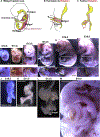Signals and forces shaping organogenesis of the small intestine
- PMID: 30797512
- PMCID: PMC12359083
- DOI: 10.1016/bs.ctdb.2018.12.001
Signals and forces shaping organogenesis of the small intestine
Abstract
The adult gastrointestinal tract (GI) is a series of connected organs (esophagus, stomach, small intestine, colon) that develop via progressive regional specification of a continuous tubular embryonic organ anlage. This chapter focuses on organogenesis of the small intestine. The intestine arises by folding of a flat sheet of endodermal cells into a tube of highly proliferative pseudostratified cells. Dramatic elongation of this tube is driven by rapid epithelial proliferation. Then, epithelial-mesenchymal crosstalk and physical forces drive a stepwise cascade that results in convolution of the tubular surface into finger-like projections called villi. Concomitant with villus formation, a sharp epithelial transcriptional boundary is defined between stomach and intestine. Finally, flask-like depressions called crypts are established to house the intestinal stem cells needed throughout life for epithelial renewal. New insights into these events are being provided by in vitro organoid systems, which hold promise for future regenerative engineering of the small intestine.
Keywords: Boundary formation; Crypt development; Epithelial-mesenchymal crosstalk; Intestinal lengthening; Intestinal organoids; Intestinal regionalization; Mesenchymal clusters; Signaling cascades; Tensile forces driving morphogenesis; Villus development.
© 2019 Elsevier Inc. All rights reserved.
Figures






Similar articles
-
Mouse Small Intestinal Organoid Cultures.Methods Mol Biol. 2025;2951:77-90. doi: 10.1007/7651_2024_576. Methods Mol Biol. 2025. PMID: 39570547
-
Stage-specific DNA methylation dynamics in mammalian heart development.Epigenomics. 2025 Apr;17(5):359-371. doi: 10.1080/17501911.2025.2467024. Epub 2025 Feb 21. Epigenomics. 2025. PMID: 39980349 Review.
-
Prescription of Controlled Substances: Benefits and Risks.2025 Jul 6. In: StatPearls [Internet]. Treasure Island (FL): StatPearls Publishing; 2025 Jan–. 2025 Jul 6. In: StatPearls [Internet]. Treasure Island (FL): StatPearls Publishing; 2025 Jan–. PMID: 30726003 Free Books & Documents.
-
RFX6 regulates human intestinal patterning and function upstream of PDX1.Development. 2024 May 1;151(9):dev202529. doi: 10.1242/dev.202529. Epub 2024 May 9. Development. 2024. PMID: 38587174 Free PMC article.
-
Blueprint for an intestinal villus: Species-specific assembly required.Wiley Interdiscip Rev Dev Biol. 2018 Jul;7(4):e317. doi: 10.1002/wdev.317. Epub 2018 Mar 7. Wiley Interdiscip Rev Dev Biol. 2018. PMID: 29513926 Free PMC article. Review.
Cited by
-
Intestinal Morphogenesis in Development, Regeneration, and Disease: The Potential Utility of Intestinal Organoids for Studying Compartmentalization of the Crypt-Villus Structure.Front Cell Dev Biol. 2020 Oct 23;8:593969. doi: 10.3389/fcell.2020.593969. eCollection 2020. Front Cell Dev Biol. 2020. PMID: 33195268 Free PMC article. Review.
-
Mechanical stretching boosts expansion and regeneration of intestinal organoids through fueling stem cell self-renewal.Cell Regen. 2022 Nov 2;11(1):39. doi: 10.1186/s13619-022-00137-4. Cell Regen. 2022. PMID: 36319799 Free PMC article.
-
The Effect of Thiol Structure on Allyl Sulfide Photodegradable Hydrogels and their Application as a Degradable Scaffold for Organoid Passaging.Adv Mater. 2020 Jul;32(30):e1905366. doi: 10.1002/adma.201905366. Epub 2020 Jun 17. Adv Mater. 2020. PMID: 32548863 Free PMC article.
-
Mechanical stimulation promotes human intestinal villus morphogenesis in vivo.Biophys Rev (Melville). 2024 Jul 19;5(3):032102. doi: 10.1063/5.0221220. eCollection 2024 Sep. Biophys Rev (Melville). 2024. PMID: 39036707 Free PMC article. No abstract available.
-
Developmental regulation of cellular metabolism is required for intestinal elongation and rotation.Development. 2024 Feb 15;151(4):dev202020. doi: 10.1242/dev.202020. Epub 2024 Feb 19. Development. 2024. PMID: 38369735 Free PMC article.
References
-
- Applegate KE, Anderson JM, & Klatte EC (2006). Intestinal malrotation in children: A problem-solving approach to the upper gastrointestinal series. Radiographics, 26, 1485–1500. - PubMed
-
- Arnaout R, & Stainier DYR (2011). Developmental biology: Physics adds a twist to gut looping. Current Biology, 21, R854–R857. - PubMed
-
- Barker N, Huch M, Kujala P, van de Wetering M, Snippert HJ, van Es JH, et al. (2010). Lgr5(+ve) stem cells drive self-renewal in the stomach and build long-lived gastric units in vitro. Cell Stem Cell, 6, 25–36. - PubMed
Publication types
MeSH terms
Grants and funding
LinkOut - more resources
Full Text Sources

